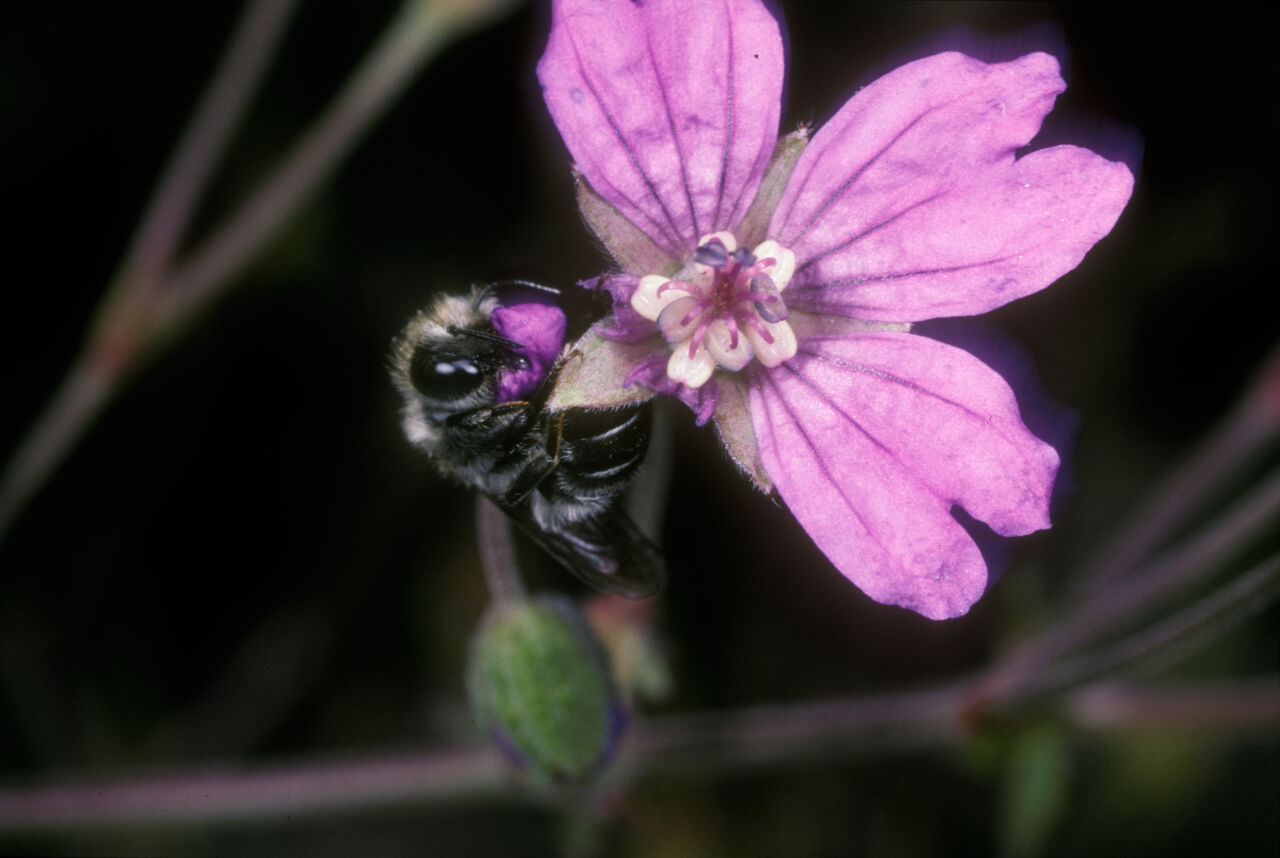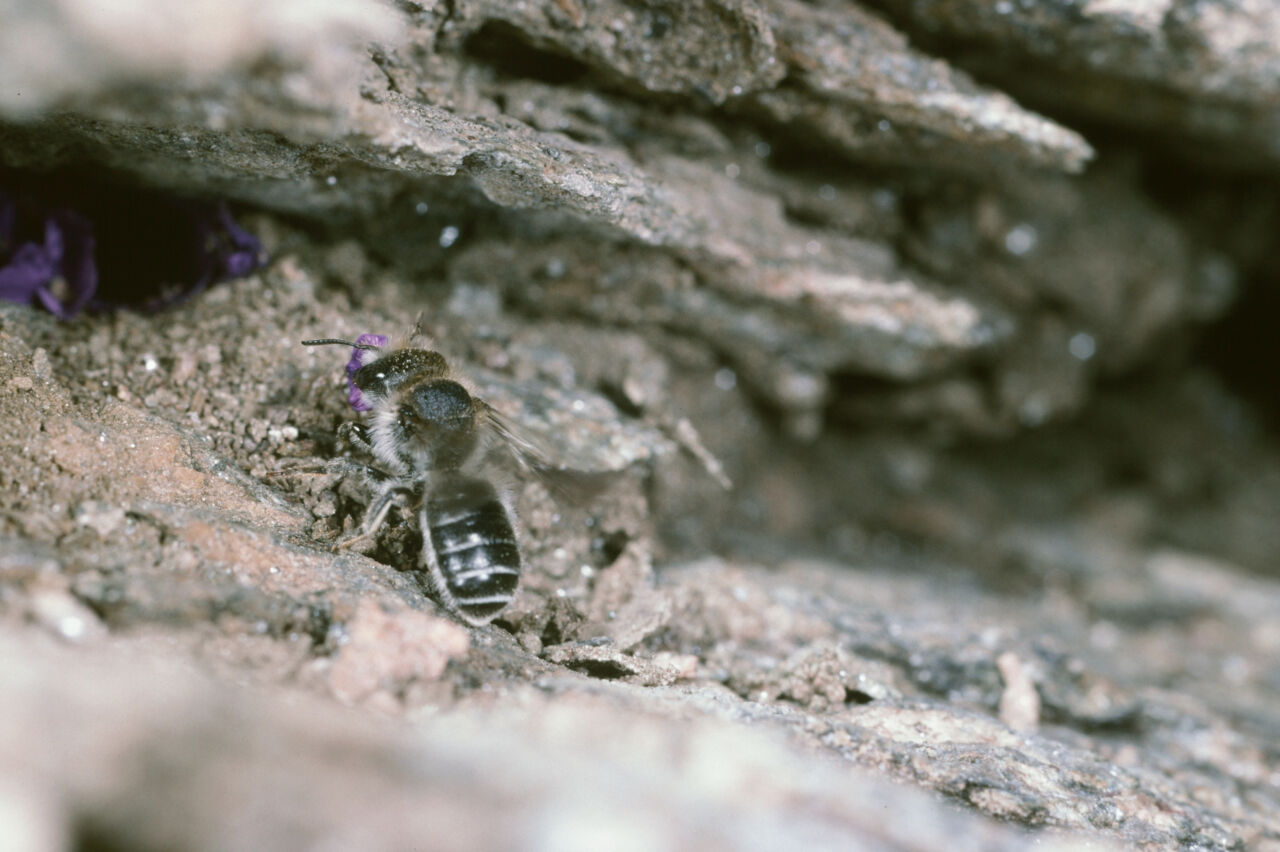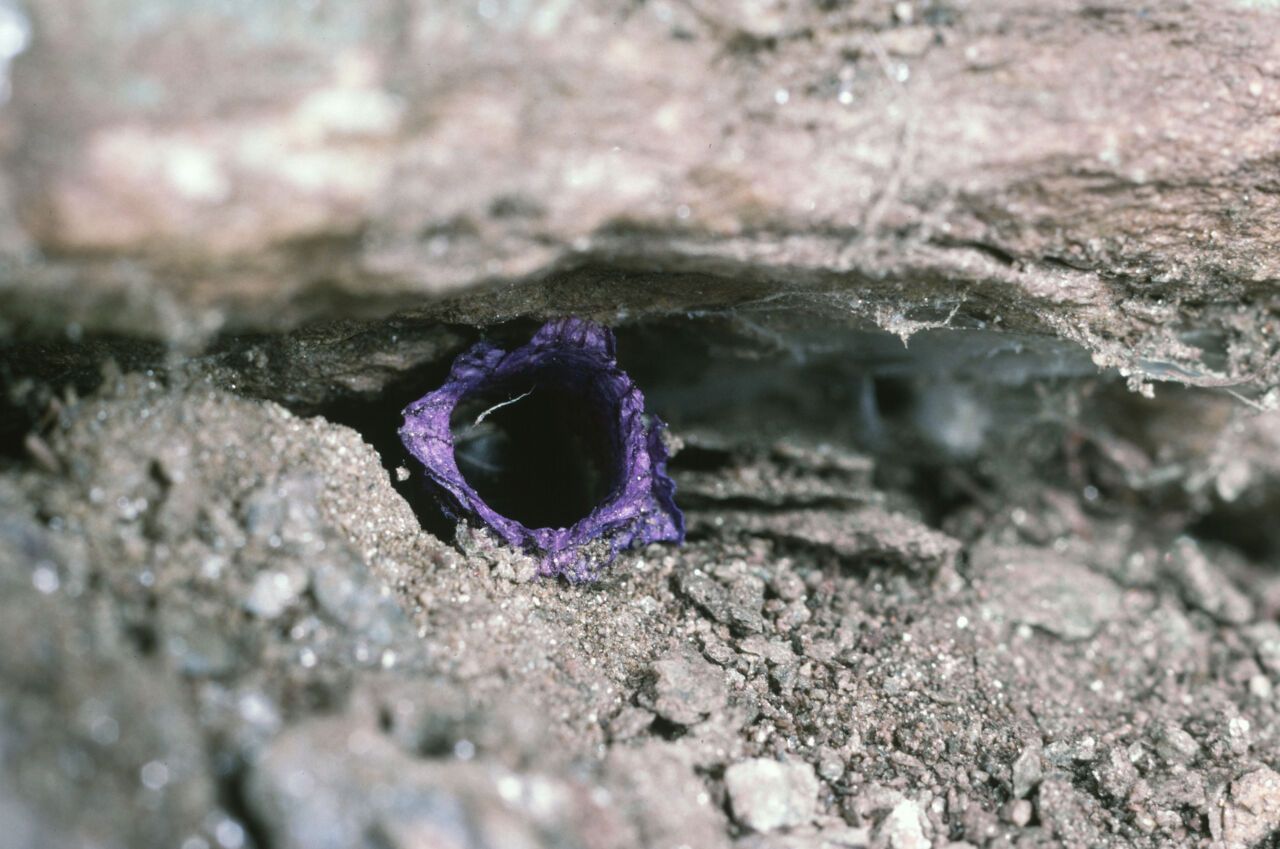Osmia tergestensis: The Gaudí of the bees
Osmia tergestensis uses flower petals to construct some of the most elegant and charming constructions made by insects.

A female bee with beads from petals of Geranium pyrenaicum (mountain cranesbill). Image: Entomologie/Botanik, ETH Zürich/Albert Krebs, CC license
Profile
- Osmia tergestensis, the Osmia of Trieste, is a solitary bee that belongs to the Megachilidae family.
- It is the size of a ladybug, shiny black and sparsely covered with long greyish-yellow hairs.
- They are widely distributed across Europe.
- They fascinate by their artfully constructed nests.
- The genus Osmia are important crop pollinators: In their presence, cherries reach the optimum quality earlier, strawberries reach bigger sizes, and apple trees reach higher yields.
Classification
- Kingdom
- Animalia
- Phylum
- Arthropoda
- Class
- Insecta
- Order
- Hymenoptera
- Family
- Megachilidae
- Genus
- Osmia
- Species
- O. tergestensis
Do bees use flowers only as food sources? Of course not. Male orchid bees in tropical America collect scented oils from flowers to attract mates; male carpenter bees often use flowers for a good night’s sleep; and the females of several species of leafcutter bees use flower petals to build brood cells, i.e., nests to lay their eggs into, resulting in tiny colorful works of artistic craftsmanship.

A nest of Osmia tergestensis in the grass. Image: Entomologie/Botanik, ETH Zürich, Andreas Müller, CC License
Encounter in Trieste
In the summer of 1896, in Trieste, 21-year-old Adolpho Ducke, an Italian naturalist of German descendants who would later become a leading advocate for the conservation of the Amazon rainforest in Brazil, discovered a new species of leafcutter Osmia bee, which he named Osmia tergestensis (Osmia of Trieste). No bigger than a ladybug, this bee is shiny black and sparsely covered with long greyish-yellow hairs that offer a somehow glowing impression.
The construction stars among the solitary bees
This brilliant little architect has gained its reputation owing to its particular nesting behavior. Solitary bees provide parental care to their offspring by securing that, once they hatch, their little ones (the larvae) will find enough food to sustain them until pupation. To achieve this, they construct brood cells in various types of cavities (e.g., crevices, old wood, into the ground, etc.), in which they lay one precious egg, put some food next to it for the hatchling, and seal the opening, usually with mud. Leafcutter bees are exceptional among solitary bees because they have evolved to use fresh leaves for building the brood cell walls; for this, they have developed special razors on their jaws, which make leaf-cutting an easy task. Yet, one group of species within leafcutters has specialized in using flower petals instead of leaves, resulting in some of the most elegant and charming constructions made by insects.
To view this content, you must accept marketing and third-party cookies.
Artists at work
How do you build a brood cell from flower petals? First, you need an already existing cavity; O. tergestensis often prefers rock crevices and fissures. Second, you need 50-60 petals from plants like geranium, rockrose, hawkweed, flax, or restharrow. Third, you need mud and tiny pebbles. To begin with, you coat the natural wall of the cavity with a first layer of petals, so that each petal partly overlaps with the adjacent one. Then, you overlay mud and pebbles, and before this mixture dries up, you cover it with another layer of petals. Once you have laid your egg inside the chamber and added the necessary food provisions (nectar and pollen), you seal the opening with a plug made of moist soil. Finally, you camouflage the nest with more petals and other materials from the vicinity.
Bedded on roses
This petal-mud-petal sandwiched brood cell is not only a pleasure to the human eye, but also a sophisticatedly engineered artifact, allowing baby bees to survive until adulthood. Although, to date, the ecology and evolution of this behavior have not been sufficiently studied, we can hypothesize about the advantages of using petals for brood cell construction. For instance, because petals have excellent water-repellent properties, they can protect the eggs and the larvae from flooding, but also preserve the desired levels of humidity inside the chamber. Moreover, the multiple layers allow the cell to float, in case it is carried away by water. In addition, the slender petals are easier to handle than leaves, making the life of the mom bee a little less painful: petals are easier to cut, carry, fold, arrange, and glue together. Bee scientists believe that another possible benefit is due to the scent of the petals, which often includes several compounds with antiseptic properties, offering an extra protection to the larvae.
Did you know?
Although the Osmia of Trieste was first discovered in Northeast Italy, it has a relatively wide geographical distribution and, at least in Europe, it is considered of the least concern regarding its conservation status. Specifically, these little craftsmen can be found in most of the Mediterranean, in Central Europe up to Southern Poland and Southern Ukraine, and eastwards up to Kazakhstan. This range does include Switzerland: several little masterpiece nest cells have been discovered in the limestone rocks of the Swiss pre-Alps in the Cantons of Valais and Ticino, at an elevation between 1,000 and 2,000 m. So, if you happen to hike around Zeneggen (VS) in late July (after the new bees have emerged!), you may want to take a closer look inside rock cavities; perhaps you are lucky enough to find a little flowery souvenir, made with outstanding art by a mother leafcutter (or should we say petalcutter) bee.
References
Amiet F et al. 2004. Apidae 4: Anthidium, Chelostoma, Coelioxys, Dioxys, Heriades, Lithurgus, Megachile, Osmia, Stelis. Fauna Helvetica, 9: 1–274.
Ducke A. 1897. Aufzählung der bei Triest im Jahre 1896 von mir gesammelten Osmia-Arten und Beschreibung einer neuen Art. Entomologische Nachrichten, 23:38-43. https://digitalcommons.usu.edu/bee_lab_da/388/
Müller A. 2020. Palearctic Osmia bees of the subgenera Hemiosmia, Tergosmia and Erythrosmia (Megachilidae, Osmiini): biology, taxonomy and key to species. Zootaxa, 4778: 201-236. https://doi.org/10.11646/zootaxa.4778.2.1
Nieto A et al. 2015. European Red List of bees. Publication Office of the European Union, Luxembourg. https://www.google.com/url?sa=t&rct=j&q=&esrc=s&source=web&cd=&ved=2ahUKEwixivzZ0JL_AhVigv0HHYu2D6kQFnoECAoQAQ&url=https%3A%2F%2Fportals.iucn.org%2Flibrary%2Fsites%2Flibrary%2Ffiles%2Fdocuments%2FRL-4-019.pdf&usg=AOvVaw1udaSZgV8NeeQ9M9Dqr8oQ
Rozen JG et al. 2010. Nests, petal usage, floral preferences, and immatures of Osmia (Ozbekosmia) avosetta (Megachilidae: Megachilinae: Osmiini), including biological comparisons with other Osmiine bees. American Museum Novitates, 2010:1-22, 22. http://dx.doi.org/10.1206/701.1





